Van Gogh Museum Journal 2001
(2001)– [tijdschrift] Van Gogh Museum Journal–
[pagina 62]
| |
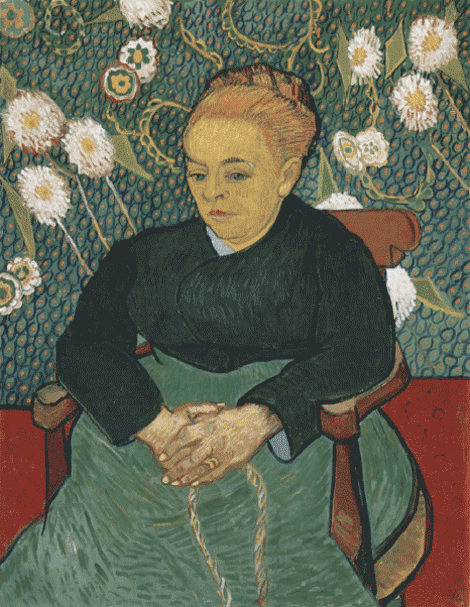 fig. 1
Vincent van Gogh, La berceuse (F 508 JH 1671), 1888/89, Boston, Museum of Fine Arts, bequest of John T. Spaulding | |
[pagina 63]
| |
Tracing a transformation: Madame Roulin into La berceuse
| |
[pagina 64]
| |
ferred it; and that The Art Institute's Berceuse, the second in the series, corresponds exactly to the underdrawing rather than the final painted contours of its predecessor in the Museum of Fine Arts, Boston, which can only be explained by a tracing previously made from the initial sketch. In the case of the Sunflowers, not only the later January versions but also the work on jute (F 457 JH 1666), determined by our study to have been painted in December 1888, were begun with tracings taken from the original August paintings. In developing the initial composition for La berceuse (F 508 JH 1671, fig 1), also in December, Van Gogh traced part of an earlier painting and later employed tracing to repeat the composition. Both motifs, it should be noted, were also associated with Gauguin. The discovery of Van Gogh's use of tracing in La berceuse is particularly interesting because portraiture was central to his practice and mission. A picture constructed using various pre-existing elements rather than painted from life, La berceuse marks a greater departure from basic principles on Van Gogh's part - and a greater responsiveness to Gauguin's ideas - than had previously been imagined. Van Gogh acknowledged this later in a letter to Emile Bernard in which he made a statement about La berceuse that is perplexing if we assume he based the work solely on studies from life - as was more typical for his portraits - but makes perfect sense in the context of the procedure outlined in this essay: ‘When Gauguin was in Arles, I once or twice allowed myself to be led astray into abstraction, as you know, for instance in the Berceuse. [...] At the time, I considered abstraction an attractive method. But that was delusion, dear friend, and one soon comes up against a brick wall’ [824/B21]. | |
TracingA tracing is made by placing a thin, translucent paper (called papier calqué or papier végétal in French) over a source image and following the contour lines with a pencil, crayon, etc.Ga naar voetnoot5 The traced image can then be transferred by several methods. The simplest is to apply a friable medium such as chalk or charcoal to the reverse of the paper, place this chalked side against the new surface, and retrace the lines with a pointed tool or pencil, thereby transferring lines of chalk from the reverse to the fresh surface.Ga naar voetnoot6 Another method is to chalk a thin sheet of paper and slip it between the tracing and the new surface. By this ‘carbon copy’ method, the back of the original need not be covered with chalk. These methods of transfer would of course transfer the image in the same size (one-to-one).Ga naar voetnoot7 Our technical examinations of Van Gogh's works painted during the period from late 1888 to early 1889 revealed that he almost invariably began by making a light charcoal contour sketch on the primed canvas, outlining areas of the composition and (in the case of portraits) the features of a sitter in a most summary manner. Occasionally he would then reinforce the charcoal lines with a painted sketch, sometimes also laying in thin, flat underlayers of colour;Ga naar voetnoot8 but more frequently he proceeded directly from the charcoal underdrawing to applying his thick, gestural, interwoven brushstrokes. He generally worked within the areas delineated by the contour sketch, making only slight deviations and adjustments; during the final steps of painting he often covered the join between adjacent areas of colour with a heavy contour line. The charcoal contours transferred from the back of a tracing would have functioned in an identical manner to contours sketched freehand. Snatches of these charcoal underdrawings, where they have not been covered by paint layers, can be seen on Van Gogh's paintings with the aid of a microscope, but these areas are so small that no distinction can be made between freehand and transferred lines.Ga naar voetnoot9 The evidence for this new discovery regarding Van Gogh's tracing practice is mainly circumstantial. Only two | |
[pagina 65]
| |
tracings have been preserved, both from the Paris period, but these are squared for enlargement and were not used for direct transfer. In contrast, for example, to prints with grids, such tracings had no intrinsic value and if the reverse had been blackened would have been difficult to store as well. Nor does Van Gogh ever mention tracing in his letters - although this does not necessarily mean much, as he is rather reticent about such matters in general. The proof that Van Gogh did indeed use tracings was delivered when the relevant works were scanned and sized to scale with the aid of a computer. Printed out on transparent melinex, the images were then laid on top of one another. The similarities thus revealed were so astonishing that it was immediately obvious - even without primary evidence - that the artist had indeed used the tracing method. It seems possible Van Gogh already employed tracings in Nuenen. There is, for example, a remarkable correspondence between the two versions of a head of an old peasant woman (F8oa JH 682 and F 388r JH 732). Similarly, there is a literal correlation between the contours and facial feature in three studies of a young peasant girl (F 85 JH 693, F 141 JH 783 and F 160 JH 772). In both these cases Van Gogh used the same head for different artistic experiments with colour and brushwork. In Paris, too, it seems Van Gogh made use of tracings, for example in copying the Japanese prints found in the background of the large Portrait of Père Tanguy (F 363 JH 1351): the painted copies are precisely the same size as the original woodcuts and the intricate design of Toyokuni III's Miurayano Takao: a geisha, for example, is reproduced exactly. Up to this point, Van Gogh's use of tracing had been somewhat sporadic, relating either to the production of replicas, to artistic experiments, or feeding into the major pictorial statement of a tableau. He only truly began to use the method on a broader scale in Arles, where he came to rely on it more and more in the course of 1888. It can be demonstrated that he used tracing to transpose drawings into paintings in Path through a field with willows (F 407 JH 1402) and Fishing boats on the beach (F 413 JH 1392); and to develop the portrait sketch into a finished work in the Portrait of Patience Escalier (F 443 JH 1548). This latter effort, the leap from study to fully realised pictorial statement, was a long-held goal. In the summer of that year, awaiting Gauguin's arrival, Van Gogh had been explicit about his hope that the former would facilitate his production of tableaux, and this expectation conditioned his receptiveness (and resistance) to his friend's approach and method. Gauguin, observing Van Gogh's preference for painting quickly before the motif, demonstrated his own techniques of working from the imagination and of synthesising a picture by combining elements from different sources. He got a prime opportunity to do so when their neighbour, Madame Ginoux, came to the studio to pose for both artists in early November. After drawing a large portrait of Madame Ginoux (fig. 2a), Gauguin traced and transferred her onto his canvas The night café (fig. 2b), borrowing the setting from Van Gogh's September composition of the same scene (F 463 JH 1575) and inserting caricatures of Van Gogh's friends the Zouave and the postman into the background. It is not known whether Gauguin used tracing before coming to Arles. To be sure, he often made full-size preparatory drawings, but evidence suggests that up until this point he usually reproduced these drawings on canvas by squaring rather than by tracing and chalking.Ga naar voetnoot10 Perhaps Van Gogh suggested that Gauguin try the more direct tracing method and even supplied the tracing paper (he had similarly supplied prepared canvas when Gauguin first arrived).Ga naar voetnoot11 At the same time, Gauguin encouraged Van Gogh to borrow his own, more far-reaching methods of pictorial synthesis and to experiment more freely with composing from the imagination. | |
[pagina 66]
| |
Madame RoulinIn one sense, the portraits Van Gogh painted of the Roulin family - beginning in late November and continuing into December - represent a return to the more familiar ground of working directly from nature, following his brief but stimulating foray with Gauguin into the realm of painting from the imagination, as seen in experimental works such as Brothel scene (F 478 JH 1599), Spectators at the arena (F 548 JH 1653), A novel reader (F 497 JH 1632) and, most significantly, Memory of the garden at Etten (F 496 JH 1630, fig. 8). Around 4 December 1888, Vincent informed Theo of his retrenchment: ‘I have spoiled that thing that I did of the garden in Nuenen, and I think that you also need practice for work from the imagination. But I have made portraits of a whole family [...] You know how I feel about this, how I feel in my element [...]’ [728/560]. However, in another sense Van Gogh viewed these portrait sessions as a means of moving forward in order to achieve a greater end; he continued: ‘And if I manage to do this whole family better still, at least I have done something to my liking and something individual.’ He envisioned producing more considered tableaux based on these studies, as he had done with the portrait of Patience Escalier. And, in formulating this aim, he was not denying Gauguin's synthetist methods but affirming them in service of his own humanist ideals. When Madame Roulin came to sit in late November, both Gauguin and Van Gogh painted horizontal, size 15 portraits of her (fig. 3a and F 503 JH 1646, fig. 3b), now in the Saint Louis Art Museum and the Oskar Reinhart Collection, Winterthur, respectively. Van Gogh probably completed his painting more or less in a single session, while Gauguin's required later refinement. To paint a portrait bust in the horizontal format was not a natural choice for Van Gogh; he must have followed Gauguin's lead or intended, even from the beginning, to include some allusive details in the background, inspired perhaps by the similar horizontal compositions of the self-portraits Gauguin, Bernard and Charles Laval had recently sent him. At this same time, Van Gogh painted Madame Roulin with baby (F 491 JH 1638, fig. 4a), now in The Metropolitan Museum of Art, New York, which is essentially a portrait of the Roulins' four-month-old daughter,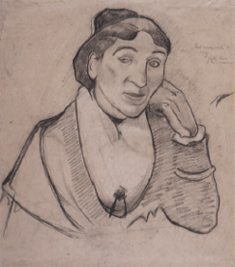 fig. 2a
Paul Gauguin, Madame Ginoux (Study for The night café), 1888, San Francisco, Fine Arts Museums of San Francisco, memorial gift from Dr. T. Edward and Tullah Hanley, Bradford, PA Marcelle.Ga naar voetnoot12 Marcelle's face received the most attention in this rapidly executed sketch, but Van Gogh also focused on the mother's hands, which he included in the initial underdrawing, held in reserve and painted towards the end of the session. He elaborated the hands with layers of different colours in thicker impasto and he included the detail of Madame Roulin's double wedding band. Tracing the baby's head as soon as he had completed the underdrawing (rather than waiting until after the paint layer had dried), Van Gogh prepared for a future work. This must have become a standard procedure, first identified by our | |
[pagina 67]
| |
 fig. 2b
Paul Gauguin, The night café, 1888, Moscow, The State Pushkin Museum of Fine Arts research in his two portraits of Patience Escalier. He similarly traced the head from the underdrawing of the Winterthur Madame Roulin (fig. 3b) to be used later.Ga naar voetnoot13 These tracings were meant to serve multiple purposes. In describing his first portraits of the Roulin family to Theo, Van Gogh declared that he hoped ‘to be able to get more careful posing, paid for by portraits’ [728/560]. In fact he gave the Roulins a portrait of each family member, several produced by means of tracing.Ga naar voetnoot14 For example, he used the tracing of Marcelle's head to paint a smaller portrait of her with the hands in a different position and then traced this new image to make two replicas (F 441 JH 1641, F 441a JH 1640 and F 440 JH 1639).Ga naar voetnoot15 Probably inspired by Gauguin's methods of compositional synthesis, Van Gogh now addressed the challenge of combining two studies in a new, larger composition. Soon after making the tracings of baby Marcelle's head and of Madame Roulin's head from the New York and Winterthur studies, he combined them together in a size 30 canvas, the Philadelphia Museum of Art's Madame Roulin and her baby (F 490 JH 1637, figs. 4b and 4c). This picture may have been conceived as a pendant to the large | |
[pagina 68]
| |
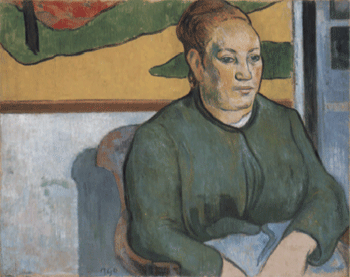 fig. 3a
Paul Gauguin, Madame Roulin, 1888, Saint Louis Art Museum, funds given by Mrs. Mark C. Steinberg (size 25) Portrait of Joseph Roulin (F 432 JH 1522, fig. 5a) in the Museum of Fine Arts, Boston. Both husband and wife are shown in three-quarter length and the background of Madame Roulin with baby was initially a pale blue similar to the background of the husband's portrait, but more turquoise in hue. It is possible that Madame Roulin and her baby actually sat for the second, size 30 representation, after Van Gogh had set the composition by transferring the tracings, much as he had done for the likeness of Patience Escalier, where he had traced the contours and features from an earlier portrait but had worked from the model while painting. The frenetic quality of the brushwork does suggest a sitting of limited time, perhaps dependent on the baby's disposition; however, Van Gogh would also dash off a painting when working from memory, as demonstrated by the loose and rapid brushwork of A novel reader. The only elements of the Philadelphia painting not included in the two earlier studies - Madame Roulin's arm, bosom and lap, along with the bottom of the baby's gown and bottom of the chair - are on the whole so awkwardly constructed that they do not appear to have had a model at all. Some areas of paint are thinly applied, and Van Gogh may have intended to build upon and refine the forms once they had been set down. He did begin to work up the thin orange and green initial modelling of the baby's face and arms with pink impasto, and likewise covered the underlayer of her gown with thick white brushwork. Perhaps at this point he became dissatisfied with the baby's part in the composition and abandoned it. But it seems more likely that the painting served as a further experimental study, and as such Van Gogh could play all the more freely with an intuitive and generalised method of constructing and modelling form. It builds upon his recent experience with working from the imagination, where in paintings such as the Brothel scene and Spectators at the arena he employed a similarly broad method of planar construction.Ga naar voetnoot16 The power of this picture and Spectators at the arena - especially for the modern viewer - is sparked by an awareness of its experimental nature: here the working process rather than the final product was paramount in the artist's mind. | |
[pagina 69]
| |
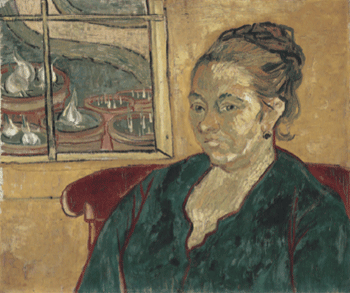 fig. 3b
Vincent van Gogh, Madame Roulin (F 503 JH 1646), 1888, Winterthur, Oskar Reinhart Collection | |
La berceuseLa berceuse (fig. 1) is the tableau that followed, in mid-December 1888, upon these studies of Madame Roulin. Like Van Gogh's first masterpiece, The potato eaters, it was not painted from life but created from the imagination, fuelled by recent portrait studies. Following the pattern exemplified, for example, by the portraits of Patience Escalier, Van Gogh held true to the particular form of the sitter's face, based on a previous study from life, but intensified the arrangement of colours, simplified the interlocking forms, added emblematic allusions to the sitter's persona and invented a resonant background. Encouraged by Gauguin's example and by his own recent work from memory, Van Gogh reached farther afield than he ever had before to draw upon elements from a variety of sources, arranging them together in a deliberately abstract and synthetic manner. For the head of La berceuse Van Gogh once again used the tracing he had made from the Winterthur Madame Roulin (fig. 3b). Out of the five versions of La berceuse, it is the head in the Boston version (figs. 1 and 5b) that most nearly matches that in the traced source (the head becomes progressively smaller in the other versions). The contours and features of the Winterthur and Boston paintings match closely, with several differences: in the latter the lines have been simplified (by adjusting the outlines, and smoothing and shortening the end of the nose and chin); the shape of the head has become more geometric (by widening the forehead and crown on the left and by straightening the hairline and eyes); and the modelling has been flattened (by eliminating tonal contrast) - all changes in the direction of abstraction. The composition of La berceuse is divided almost in half at the sitter's waist. The head centres the top portion, with the eyes riveting the viewer's amid the roiling activity of the wallpaper. In the lower portion the hands have an almost equal importance and act as the fulcrum, holding a loop of rope in the green swell of the skirt. Since Van Gogh had decided to take the baby out of Madame Roulin's hands, | |
[pagina 70]
| |
he now required a model for new hands, which he found in his August portrait of Joseph Roulin. Adding the hands to the underdrawing, he borrowed Joseph's more finished left hand for the corresponding top hand of La berceuse, perhaps using Joseph's right thumb for the hand that lies beneath (fig. 5c). He may have actually traced Joseph's hands - the disposition of proper left fingers and right thumb match the Berceuse's hands with some variations - or he may simply have referred to the August painting as a visual guide.Ga naar voetnoot17 Having now placed the husband's hands in the wife's lap, Van Gogh added the double wedding band she wears in the New York Madame Roulin with baby (fig. 4a). For the most part, Van Gogh retained the position of Madame Roulin's body as he had fleshed it out in the Philadelphia mother-and-child study (fig. 4c). However, he also borrowed several details from the horizontal portrait Gauguin had painted of her (fig. 3a): the high, rounded neckline with a hint of a white undergarment below the far side of the chin; the forearm nearest the viewer resting along the arm of the chair with the other forearm angled, and a view inside the sleeve at the wrist on the right side with the other cuff closed. These details, seen in both Gauguin's portrait and La berceuse, are not consistent with an actual sitting, where the two artists would have viewed her from opposite sides, as was discovered during our study when a to-scale model of the studio was constructed and the sittings recreated.Ga naar voetnoot18 From Van Gogh's position, for example, he would not have been able to look up the cuff on the right. Because La berceuse's round-necked costume differs from the V-shaped, open neckline shown in Van Gogh's earlier studies of Augustine Roulin, it has been suggested that she returned for a second sitting. However, it seems more likely that there was only one sitting and that the higher collar and undergarment were invented by Gauguin, who finished his portrait after the sitter had left.Ga naar voetnoot19 Borrowing these details for La berceuse, Van Gogh incorporated them in a manner that was inconsistent with observed reality. In a larger sense Van Gogh was also inspired by the calm, meditative containment of Gauguin's figure, her stolid serenity, expressed formally by large areas of flat colour contained within simple, flowing contour lines. It was this persona and more abstract style that Van Gogh chose for his Berceuse, transforming Augustine Roulin from the earthy, dishevelled mother of his first study into a serene high priestess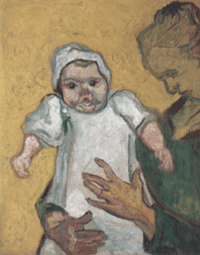 fig. 4a
Vincent van Gogh, Madame Roulin with baby (F 491 JH 1638), 1888, New York, The Metropolitan Museum of Art who, in his own references to the picture, ‘offers consolation for the broken-hearted’ [743], to the fishermen in ‘mournful isolation, exposed to all dangers, alone on the sad sea’ [747/574].Ga naar voetnoot20 From the outset Van Gogh placed his sitter against an evocative background. While it is possible that he based the design of dahlias and undulating curves on a particular wallpaper or fabric, it seems more likely that it was his own inspired creation, developed from the imagination. The full pink dahlia blossoms together with more schematic flowers, | |
[pagina 71]
| |
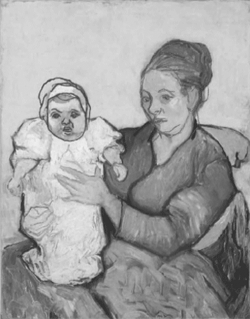 fig. 4b
Vincent van Gogh, Madame Roulin and her baby (F 490 JH 1637), 1888, Philadelphia Museum of Art, with overlays to show tracings from fig 3b (red) and fig 4a (blue) composed of flat, concentric rings of colour, are prefigured in a foreground passage of Memory of the garden at Etten (fig. 8), where both flowers types appear, set against a similar pointillist pattern of orange and blue marks. The tendrils in the Berceuse wallpaper repeat the curve of the serpentine path.Ga naar voetnoot21 The abundance of flowers recalls the fertility to which the sprouting bulbs allude in his first portrayal of Madame Roulin (fig. 3b), where the winding path was also included. In La berceuse each yellow curve of the wallpaper is elaborated with a row of smaller marks; this pattern is repeated in the yellow strokes of the twined rope, as though Van Gogh had plucked one of the tendrils from the space behind her and placed it in her lap. Not only does this visual echo tie together the upper and lower halves of the composition, but the rope - ostensibly used to rock the unseen cradle - becomes the emblem for the baby she had previously held. 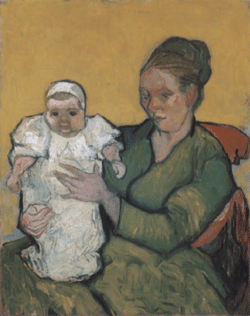 fig. 4c
Vincent van Gogh, Madame Roulin and her baby (F 490 JH 1637), 1888, Philadelphia Museum of Art, bequest of Lisa Norris Elkins | |
The ‘Berceuses’Mathematically speaking, there are 120 different sequences in which the five ‘Berceuses’ can be ordered (figs. 1, 6a-d). Rather than considering the various permutations of likely scenarios, this essay presents a sequence inferred from new evidence discovered during our technical examinations and by comparing x-rays and superimposed, computer-scaled | |
[pagina 72]
| |
 fig. 5a
Vincent van Gogh, Portrait of Joseph Roulin (F 432 JH 1522), 1888, Boston, Museum of Fine Arts, gift of Robert Treat Paine images made from uncropped transparencies - a comprehensive process that first led us to posit the necessity of tracing in the Sunflowers and ‘Berceuses.’ The sequence that this new evidence suggested in fact corroborates that proposed by Jan Hulsker, which was based on a close reading of the relevant letters:Ga naar voetnoot22
1st version: Boston, Museum of Fine Arts (F 508 JH 1671, fig. 1), begun sometime in December 1888; almost complete by 23 December (when Van Gogh was hospitalised) [743, 744/573]; 2nd session: resumed 21 January 1889 [743], completed 23 January [744/573]. 2nd version: The Art Institute of Chicago (F 506 JH 1670, fig. 6a), begun c. 24 January, completed by 28 January [747/574]. 3rd version: New York, The Metropolitan Museum of Art (F 505 JH 1669, fig. 6b), begun by 30 January [748/575], completed by 3 February [749/476]. | |
[pagina 73]
| |
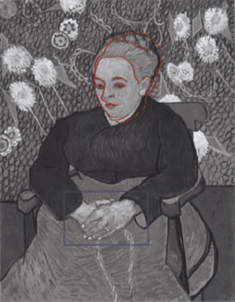 fig. 5b
Vincent van Gogh, La berceuse (F 508 JH 1671), 1888/89, Boston, Museum of Fine Arts, with tracing from fig. 3b 4th version: Amsterdam, Stedelijk Museum (F 507 JH 1672, fig. 6c), begun by 3 February [749/576], put aside by c. 7 February (hospitalised); 2nd session: resumed 21 or 22 February [752/578], probably abandoned by 24 February (hospitalised). 5th version: Otterlo, Kröller-Müller Museum (F 504 JH 1655, fig. 6d), begun c. 29 March [757/582].Ga naar voetnoot23 From this documentation we know that the second and third versions were painted quickly, each in about four days; and that the first and fourth versions were each painted in two separate sessions. One would thus expect the second and third versions to exhibit wet-into-wet paint layers in most areas, and the first and fourth to show evidence of  fig. 5c
Vincent van Gogh, Portrait of Joseph Roulin (F 432 JH 1522), 1888, Boston, Museum of Fine Arts, detail of hands, from fig. 5, repositioned in actual scale with 5b extended drying time between some layers. This is indeed the case. Microscopic examination has revealed that the Boston and Amsterdam versions had areas that weare completely dry when subsequent layers, including the hands and rope, were added; and that the Chicago and New York versions were painted very quickly, wet-into-wet - as was the Otterlo version.Ga naar voetnoot24 Van Gogh provided some specific information about the first version, describing it to Gauguin as ‘my canvas of Mme Roulin, the one in which, due to my accident, the hands had been left unfinished’ [743]. This can only be the Boston painting, the one corresponding most exactly to the tracing of his initial portrait of Madame Roulin and the version that undoubtedly took the most time. It is less direct in | |
[pagina 74]
| |
 fig. 6a
Vincent van Gogh, La berceuse (F 506 JH 1670), 1889, The Art Institute of Chicago, Helen Birch Bartlett Memorial Collection approach than the other, more systematically painted versions, as is apparent in many details, including the initial painted sketch, made on top of the underdrawing. In this sketch, the contour lines of the various elements were painted with different colours: head and bodice in brown; hands in greenish yellow; left cuff in olive green (this cuff was lengthened); flowers and leaves in light blue and green; and left chair arm in bright orange (this was one of the last elements completed).Ga naar voetnoot25 This variety reflects the piecemeal manner in which the first version was composed. Glimpses below the top paint layers reveal that Van Gogh's next step was to lay in thin, flat underlayers of colour: the face and hands in greenish yellow; the hair in a dull orange tan (these are the same colours he had used for the underlayers of the Sunflowers on jute, also painted in December and similarly developed using tracing); the  fig. 6b
Vincent van Gogh, La berceuse (F 505 JH 1669), 1889, New York, The Metropolitan Museum of Art, The Walter H. and Leonore Annenberg Collection bodice in bright green; and the wallpaper and skirt in the same shade of turquoise. In the subsequent versions, the painted sketches are not as varied, and Van Gogh often skipped the initial lay-in of colour, instead moving directly to shaping the form with intermittent brushstrokes. After the first lay-in of colour, the head of the Boston Berceuse was beautifully sculpted with yellow and orange brushstrokes of stiff dry impasto, applied to the face and hair in tightly enmeshed layers of directional strokes that render the head like one of the sunflowers in the recent Still life: vase with fourteen sunflowers (F 457 JH 1666), painted on jute. The rough, encrusted paint of the face contains dried red and green paint chips that Van Gogh must have mixed into the yellow himself.Ga naar voetnoot26 Similar dried paint chips appear in the impasto of the yellow sun in the Sower (F 450 JH 1627) and may also be found in Gauguin's two | |
[pagina 75]
| |
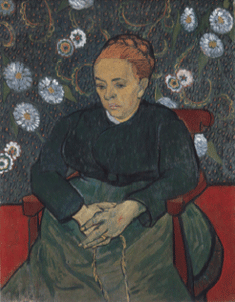 fig. 6c
Vincent van Gogh, La berceuse (F 507 JH 1672), 1889, Amsterdam, Stedelijk Museum Washerwomen (W 302 and 303), all from late November. This small detail perhaps provides additional evidence for placing the Boston version first, closest in time to other works exhibiting this same feature. The yellow complexion of the Boston Berceuse is modelled with orange and olive shading and subtle highlights of pale green, chartreuse, pink and salmon orange - a palette Van Gogh also used when copying the small Portrait of Camille Roulin (F 537 JH 1644), probably at this same time. The faces of the second and third versions of La berceuse (Chicago and New York) are modelled with similar colours. The tonality of the fourth version (Amsterdam) is duller, in part because much of the picture is underpainted in cool, neutral tones - a pinkish grey underlies the face. The Otterlo face has only minimal modelling and very few touches of varied colour. Both the face and hair were laid 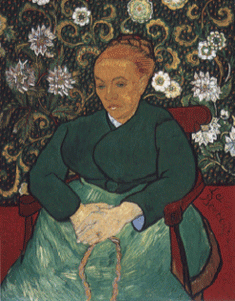 fig. 6d
Vincent van Gogh, La berceuse (F 508 JH 1655), 1889, Otterlo, Kröller-Müller Museum down together in olive yellow, only later differentiated by strokes of orange on the hair and yellow on the face. The paint application is so summary in the Otterlo version that the ground is in many places visible between the strokes; indeed, the brushwork and colour used in the face of this final version effectively function as a brief synopsis of the technique used in the earlier works.Ga naar voetnoot27 | |
[pagina 76]
| |
Although the first Berceuse was fully conceptualised and for the most part completed in December, it had developed in an organic, unsystematic way. When Van Gogh resumed work on the portrait in January 1889, the skirt, hands, rope and part of the chair and background remained unfinished. These are the elements that do not feature in either Van Gogh's or Gauguin's previous studies of Madame Roulin, and that were more slowly resolved. Evidence of extended drying time between layers indicates that before Van Gogh was hospitalised in late December the skirt had received only underlayers of paint (a first underlayer of turquoise, followed by a second, relatively flat green layer) and the hands had probably received only one flat underlayer of greenish yellow paint. On circa 21 January the artist expressed the hope that Madame Roulin might model again: ‘If I could finish it, I should be very glad, but I am afraid she will not want to pose with her husband away’ [744/573]. He apparently completed the hands that same day without a sitting, possibly referring to the August Portrait of Joseph Roulin (fig. 5a) as a model, as he had for the underdrawing in December. In a letter a day or two later, Van Gogh described the hands to fellow artist A.H. Koning as though they were finished: ‘The complexion is chrome yellow, worked up with some naturally broken tones for the purpose of modelling. The hands holding the rope of the cradle, the same’ [745/571a]. Van Gogh completed the hands quickly, with fluid strokes of many mixed colours: yellows, pinks, blues and greens, which recall the medley of colours used for her hand in the earlier portrait holding the child (fig. 4a). The chromatic range renders the hands and face closer in appearance to each other and to the artist's letter description than in any of the other versions. During the second session Van Gogh probably completed a few unfinished details of the wallpaper, gave form to the skirt with a layer of varied green and yellow strokes, completed the chair and final contour lines, and added the inscription ‘La berceuse.’ He also elaborated the rope in paint. The rope was not part of the initial underdrawing, but the artist had already indicated its position in December: he must have planned to add it when the first, turquoise underlayer of the skirt was still wet, for he marked its shape with the brush in the wet paint, leaving a textural indication of where it should go. Since this paint layer had already dried when Van Gogh returned to paint the actual rope in January, the indication for it must have been made during the first campaign.Ga naar voetnoot28 Van Gogh used tracing not only to develop the image from earlier sources, but also to produce three of the four subsequent versions. He apparently traced the contours of the first Berceuse as soon as its underdrawing was complete, using this tracing to transfer the contours of the entire figure to the canvas of the second version, executed circa 24-28 January 1889. The alignment between the Boston and Chicago versions is very close, with a slight shift down when the hands and forearms were traced (fig. 7). Certain differences result from the fact that the tracing was taken from the underdrawing of the first version rather than from the completed painting: the lower right shoulder and sleeve seam in the Chicago version follow a pentiment visible in the Boston prototype, although Van Gogh had made an adjustment in the final paint layer.Ga naar voetnoot29 Other deviations appear to be formal in nature: in the Chicago Berceuse the fingers are lengthened in one direction, the rope is swung to the other side, and the cuff is shortened to accommodate the rope. Van Gogh also made some changes to lend the figure a more solemn presence: the eyelids are lowered, the corner of the mouth is drawn downward, and the plaits pinned more tightly to the head. Adding to the solemnity, the colour of the wallpaper background is now a deep, mysterious green.Ga naar voetnoot30 The encrusted impasto in the face of the first version has become more subdued, a change paralleled in the shift from thick impasto in the December Sunflowers (F 457 JH 1666) to thinner paint application in the January versions (F 458 JH 1667 and F 455 JH 1668) - the latter painted at the same time as this second Berceuse. | |
[pagina 77]
| |
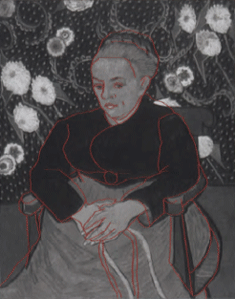 fig. 7
Vincent van Gogh, La berceuse (F 506 JH 1670), 1889, The Art Institute of Chicago, with red lines show tracing from fig. 1 Having traced and completed the second version in a matter of days, Van Gogh was emboldened to work without tracing - the third version (New York) was apparently sketched freehand and completed between 30 January and 3 February 1889.Ga naar voetnoot31 None of the contours quite align with any of the other versions. The eyes (particularly on the left) are higher in the face, the ear is smaller, the neck is a little longer and the jowl reduced. The shoulders are more relaxed, the forearms longer and more balanced, the breasts more shapely and the bottom more rounded. There is a monumentality to this version that derives from a more integrated proportionality and bolder, more dynamic contour lines. Perhaps the confidence Van Gogh demonstrated by painting freehand also led him to experiment with the position of Madame Roulin's hands, placing the proper right one on top and extending the fingers that had previously been hidden. There is nothing to suggest that Madame Roulin returned to sit again, thus providing a model for the change - in fact, the hands are even stiffer and less lifelike than before, and they hold the rope as unconvincingly. Van Gogh had agreed to let Augustine Roulin choose one of the three versions thus far completed, provided he could produce a copy of her selection before parting with it [749/576], and, as provenance research suggests, it was the New York version she selected. Van Gogh remarked: ‘She had a good eye and took the best, only I am doing it again at the moment and I do not want it to be inferior’ [752/578]. This fourth version, now in the Stedelijk Museum, Amsterdam, was thus specifically designed to be a copy of the New York work, and in its early stages Van Gogh began to duplicate the right-over-left configuration of hands that appears only there. But, surprisingly, this initial attempt to copy the hands is the only element in the Amsterdam work that is actually similar to the version the artist meant to duplicate. He did not attempt to copy the new contours and proportions and he did not repeat its freehand approach. As he was beginning to experience a recurrence of the attacks later diagnosed as epilepsy, he may have lacked the confidence to do so. And he could not work from a tracing of the New York version, since he had not traced its sketch and its paint was still very wet. Instead he began the Amsterdam painting with the tracing of the Boston Berceuse. The alignment of facial features and body contours is extremely close, but in the Amsterdam version the head is significantly | |
[pagina 78]
| |
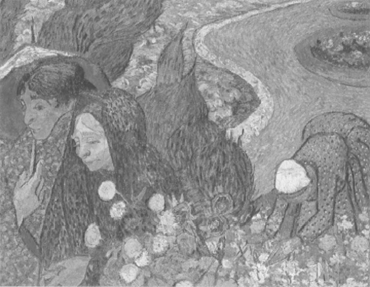 fig. 8
Vincent van Gogh, Memory of the garden at Etten (F 496 JH 1630), 1888, St Petersburg, The State Hermitage Museum shorter at the top and narrower at the back. The shape of the head has become a more nondescript oval and the contours in general are more flaccid. After establishing the figure, Van Gogh sketched the reversed hands of the New York version into place. He got as far as the underpainting before he was taken to the hospital on 7 February.Ga naar voetnoot32 By the time he resumed painting two weeks later, Madame Roulin had left Arles to live with her mother, presumably taking her Berceuse along. Without the New York version to serve as a guide Van Gogh decided to return to the hands of the Boston version. It seems, in fact, that he may have used the tracing of the Boston Berceuse to add the hands onto the partially completed painting. As he did this the tracing paper apparently shifted slightly, which could account for the elongated hand and the broad middle finger.Ga naar voetnoot33 After only a few days of painting, Van Gogh returned to the hospital and left the Amsterdam version unfinished. Large areas of the skirt have only an incomplete turquoise underlayer, many leaves lack their final contours and most of the large dahlias were apparently left as a first lay-in on top of the background colour. This is the only version that is not inscribed - another indication that it was not completed. It is difficult to say whether Van Gogh again used the Boston tracing one month later for the final version, now in the Kröller-Müller Museum, Otterlo, or whether he might actually have made a tracing of the fourth version. Possibly he used both. The body matches both and the hands are closer to the Boston tracing, but the head matches the smaller size of the Amsterdam version. It seems almost as if Van Gogh wished to pick up where he had left off with the unfinished version, correcting its weaknesses and bringing it to completion. The contours in the Otterlo work | |
[pagina 79]
| |
have regained their animation. Triangulating the head in the manner of the early versions Van Gogh exaggerated this shape by narrowing the neckline, while retaining the double contour at the top edge of the bodice, which had only appeared in the Amsterdam version. In this final version he also changed the proportions of the body by lowering the waist. In a letter of 29 March, in which Van Gogh mentions that he was painting La berceuse for the fifth time, he stated that ‘it has not even the merit of being photographically correct in its proportions or in anything else. But after all, I want to make a picture such as a sailor at sea who could not paint would imagine to himself when he thinks of his wife ashore’ [757/582]. This comment may reflect how far Van Gogh now had come from the actual live model by working from his imagination and from his own original studies and tracings.Ga naar voetnoot34 Having determined how tracing was used to compose the five versions of La berceuse, it is now possible to separate out certain elements that Van Gogh consciously adjusted to differ from the tracing and also to identify those parts of the compositions that were created without tracing. This comparative analysis gives insight into the artistic problems that concerned Van Gogh at the time and reveals progressive developments in certain directions. The hands and rope were the aspects of La berceuse that troubled Van Gogh the most. In the first version he experimented with active brushwork and colour on the hands, but he abandoned this in subsequent versions, perhaps because it drew attention to them. In the second version, he tried lengthening the fingers of one hand and swinging the rope to the side, making both into more dynamic elements of the composition; in the third, the diagonals are strengthened by extending the fingers of both hands. Besides switching the hands' position in the New York version, he initially planned for only one diagonal segment of rope - the left portion was not drawn or held in reserve but was instead added later, over the skirt. In the fourth version, the hands are elongated (perhaps by a shift in the tracing, as suggested above) and none of the rope was included in the underdrawing, again being added after the skirt was painted. In the fifth and final version Van Gogh perhaps decided that the best way to deal with the awkward rope and hands was to de-emphasise them - the hands are thinly painted in neutral tones, the contours around them are less pronounced (although now possibly faded from an originally darker tone), while the viewer's eye is drawn instead to the surrounding area of the skirt, which is energised with more dynamic brushwork, thicker impasto and stronger colours than those used in the other versions.Ga naar voetnoot35 These changing configurations of the hands and rope indicate Van Gogh's difficulty in portraying these elements convincingly and integrating them into the composition, perhaps ultimately stemming from his dissatisfaction with not having painted the hands from life. As Van Gogh varied the berceuse's, hands, he also changed the ring on the third finger of her left hand, replacing her wedding band, in progressive stages, with a large blue jewel. In the first Berceuse, Madame Roulin wears double gold bands, as in the New York mother-and-child portrait painted from life (fig. 4a). In the second version, Van Gogh initially painted the same double wedding band, but then added a blue jewel on the upper band and painted out the lower one. This was probably at the same time that he was adding orange dots to the wallpaper, for he used the same colour, which does not blend well with the hand. Perhaps the original wedding band was too strong an allusion to the outside world and Madame Roulin's everyday role as wife. In the third version, Van Gogh covered her ring finger by placing her right hand on top. In the fourth, after abandoning the right-over-left | |
[pagina 80]
| |
hands, he returned to the first depiction, including the double bands. For the final version, however, a ring with an enormous blue jewel - the lump of impasto as impressive as a real gemstone - is set upon her finger.Ga naar voetnoot36 This embellishment is in keeping with the greatly elaborated wallpaper and skirt of this version, the other areas where his imagination came into play. The wallpaper design was the area of the composition where Van Gogh gave his imagination free rein. He did not use tracing, but always sketched it freehand. For the first, second and third versions, the design is part of the charcoal underdrawing. After this he no longer required the drawing, simply painting the pattern on top of the background colour. By eliminating the underdrawing, he could apply the large block of background colour more quickly, without painting around the edge of every flower, leaf, stem and curve. With each version of La berceuse, Van Gogh progressively added new elements to the wallpaper. In the Chicago picture, he refined the positions of the elements - a placement he followed in the next two versions - and also added a large leaf on the left, two extra curves at the edges and further elaborated several of the existing curves. In the New York version he added a new stem and curve in the space above Madame Roulin's head and incorporated several naturalistic details - adding interior veins to the leaves and more overlapping pointed petals to the dahlia blossoms. The wallpaper was left unfinished in the Amsterdam Berceuse, but Van Gogh had begun to define the dahlias' pink pointed petals, as in the previous version.Ga naar voetnoot37 He also added two new curves, one above and one at the back of Madame Roulin's head. The progression culminates in the phantasmagorical design of the Otterlo Berceuse. Van Gogh used a very similar wallpaper design in one of the three versions of the Portrait of the postman Joseph Roulin (F 436 JH 1675, fig. 9a), also painted in the spring of 1889. The wallpaper in this Postman, now in the Museum of Modern Art, New York, seems to be an intermediate step between the New York and Otterlo Berceuse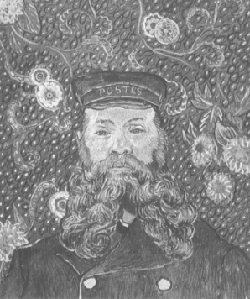 fig. 9a
Vincent van Gogh, Portrait of the postman Joseph Roulin (F 436 JH 1675), 1889, New York, Museum of Modern Art designs, which possibly dates it somewhere between them. The Postman wallpaper, like that of the New York Berceuse, has articulated veins in the leaves, but the inclusion of the deeply cut edges and tripartite structure typical of dahlia leaves makes them more naturalistic. In the Otterlo Berceuse Van Gogh elaborated them further, cutting the leaves into surreal, feathery fronds. However, the Otterlo Berceuse and the New York Postman share the branching structure of serpentine curves and the same flower grouping: both have a closed dahlia bud (drooping realistically as dahlia buds do) set against each set of three | |
[pagina 81]
| |
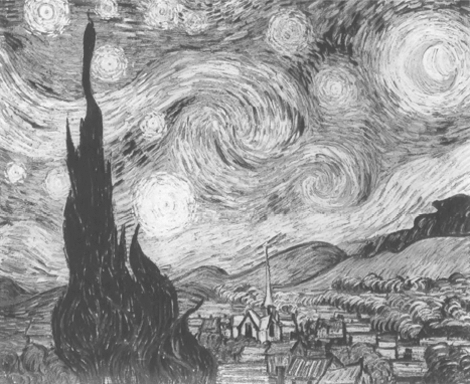 fig. 9b
Vincent van Gogh, Starry night (F 612 JH 1755), 1889, New York, Museum of Modern Art, Mrs. John Hay Whitney Bequest | |
[pagina 82]
| |
full blossoms.Ga naar voetnoot38 This is not immediately obvious because in the Postman the flower group has been rotated 180 degrees. On at least one occasion Van Gogh had turned a Berceuse upside down on the easel as he painted the wallpaper, and this may also explain the rotated flower group in the Postman.Ga naar voetnoot39 In the Otterlo version of La berceuse every element of the wallpaper has become more elaborate and the space overflows with an abundance of flowers and curves. When working from the imagination as here, Van Gogh had no natural endpoint. Thus, as in Memory of the garden at Etten (fig. 8), he continued to elaborate the surface.Ga naar voetnoot40 In contrast to the abbreviated, almost staccato brushwork of the face, the wallpaper is fully developed, with multiple layers of textural impasto and varied colours that give dimension to the forms. The entire picture is painted with loose, rhythmic brushstrokes, applied with a sure hand and sense of purpose that Van Gogh had acquired by painting the composition so many times before. Like a musician playing a familiar piece he confidently controlled the rhythm, the clarity of the notes and the variations in dynamics. The artist himself later described the act of copying a composition in similar terms: ‘And then my brush goes between my fingers as a bow would on the violin, and absolutely for my own pleasure’ [806/607].Ga naar voetnoot41 In this particular piece, the intricate elaboration of the wallpaper design may be the performer's colourful cadenza. The preponderance of expressive repeating curves seen in the wallpaper of the Otterlo Berceuse had hitherto not been a feature of Van Gogh's style. These curves mark a stage in a progression: from the serpentine path in Memory of the garden at Etten, reiterated in the first study of Madame Roulin; through the repeating curves in the wallpaper design of the first Berceuse and the Portrait of Doctor Félix Rey (F 500 JH 1659); to the elaborately scrolled curves of the Otterlo Berceuse and two versions of the Postman (F 435 JH 1674 and fig. 9a). These curving strokes would finally evolve into one of Van Gogh's most signature brush patterns and stylistic elements. In St-Rémy they moved out of the abstract portrait space and into the landscape and sky, as seen in paintings such as Starry night (F 612 JH 1731, fig. 9b). | |
CodaVan Gogh's series of portraits of the postman Joseph Roulin could be analysed using the same principles detailed above. These likenesses of Augustine Roulin's husband were done at about the same time as the 1889 ‘Berceuses,’ but there are no letter references to them and the sequence has not yet been carefully studied in light of the information that in-depth technical examinations can provide. They, too, are based on the use of tracing, with significant deviations and developments in the different versions. The nuances in the painting methods used, together with the naturalistic and schematic tendencies they exhibit, are surely intertwined with those of La berceuse. While many other possible uses of tracing in Van Gogh's oeuvre have yet to be fully explored, there are two portrait series after the ‘Berceuses’ that can be mentioned in addition to the ‘Postmen.’ One group is a pair of self-portraits done in August and September 1889, in St-Rémy.Ga naar voetnoot42 The first, in which Van Gogh holds a palette (F 626 JH 1770), was presumably done from life and was definitely traced to produce the second (F 627 JH 1772), in which he portrays himself against an abstract pattern of serpentine curves that is a continuation of the evocative space developed in La berceuse. | |
[pagina 83]
| |
Another set of portraits that depended on tracing is the series of five ‘Arlésiennes’ (F 541 JH 1893, F 540 JH 1892, F 542 JH 1894, F 543 JH 1895 and an additional version, mentioned as lost in a letter from the asylum director, Dr. Peyron). These were painted one year after the ‘Berceuses’ and depict the other woman at Arles with whom Van Gogh had an unusually sympathetic rapport, Marie Ginoux. They also allude directly to Arles through their source image: not one of Van Gogh's own portraits of Madame Ginoux, but the drawing of her that Gauguin had made in the first weeks of their collaboration and had left behind (fig. 2a). It would not be surprising to find a development in these portraits that is informed by the Berceuse series, and it is tempting to speculate that in the final version of L'Arlésienne Van Gogh elaborated the background with a pattern of flowers that was both evocative of Madame Ginoux's persona and emblematic of the artist's interaction with Gauguin.Ga naar voetnoot43 |
|

